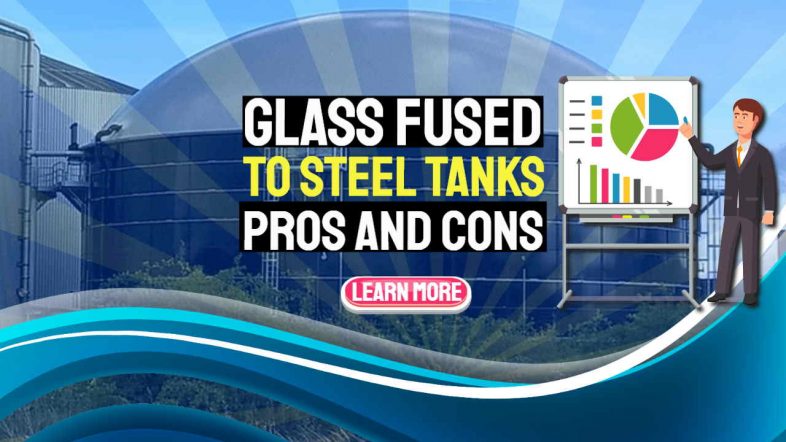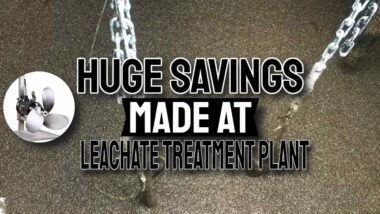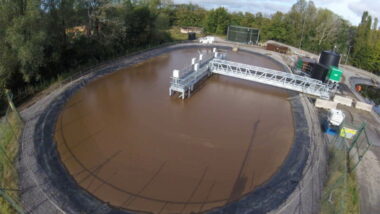Glass Fused to Steel Tanks (GFS) are popular for leachate treatment applications. However, they do have some negative characteristics. We thought it would be useful to discuss our view of GFS tanks. Read on to find out more!
Introducing Glass Fused to Steel Tanks (GFS)
CSTR biogas digester tank tanks are the most popular tank specifications. We will discuss the pros and cons of each.
This tank construction technology can be described using a variety of terms, including GFS tanks (GFtS), enamel tanks (ENA), and Glass Fused Bolted Steel tanks (Porcelain Enamelled).
Leachate treatment tanks should always be durable. This means that they must resist corrosion, impact, and abrasion. Although these tanks possess this characteristic, the steel tank material used is inherently prone to corrosion by oxidation in aerobic tanks. If penetration occurs in a leachate aeration tank, despite the pH being close to neutral it can be surprising how fast a corrosion cell at the exposed point of damaged steel can develop into a leak.
Points in Favour of “Glass Coating to Steel” Technology
The premium coating technology in the storage tank industry is without doubt glass-fused-to-steel. Glass Fused-to-Steel tanks are used in many applications in addition to leachate treatment and storage, including bio-energy, municipal sewage and industrial wastewater treatment.
Is it really that difficult to choose the right tank material?
It shouldn’t be difficult to choose a liquid storage container. It’s a liquid storage tank. What is the difference?
The answer is that all types of tanks have their benefits and disadvantages. The only way to find the best product is to compare them against your requirements.
Tanks Made of Glass Fused to Steel
Bolted tanks made of glass-fused steel (or enamelled steel) are a premium next-generation technology designed for long-term performance with minimum maintenance.
Because they combine the hardness of steel with the corrosion resistance of glass, these tanks are not only the most popular tank material for wastewater and leachate treatment. They’re also great for holding potable water, dosing chemicals, many industrial reagents, bio-digesters, sludge, and dry bulk materials.
During manufacture “frit d’enamel” (ground glass) is chemically fused with steel sheets at very high temperatures (800 – 1,000 degrees C) in a cutting-edge furnace to create an integrated porcelain-like coating that is securely bonded, chemically inert, and through which no can pass.

Suppliers claim that these tanks can tolerate temperatures ranging from 140°F to and from 3-11 pH without corroding.
They also have a lengthy track record of proven performance, with tens of thousands installed for municipal and industrial purposes worldwide over the last 65 years.
What is Enamel Frit?
Glass compounds are chemically fused to steel sheets at high temperatures (800-1000 degrees C) to create an integrated porcelain-like coating known as frit. This is chemically inert and physically inert and very hard, resisting erosion by grit and small stones.
More Merits of Glass Fused to Steel Coated Tanks
They have also been used in countless industrial and municipal applications worldwide for the past 65 years.
Advantages of glass fused to steel tanks
Glass fused to steel liquid containers combine the strength and flexibility that steel offers with remarkable corrosion resistance. This storage tank has many advantages over traditional epoxy-coated or welded painted storage containers, including:
- Amazing anti-corrosion properties
- Fast installation in the factory is combined with high-quality design, production and quality control.
- Operators are automatically safe and skilled: There is no long-term training required. Also, the plant owner has virtually no maintenance so his operatives spend much less time up there working on GFS tanks.
- These tanks are not affected by the local weather
- For industrial wastewater treatment projects and biogas digesters, a low initial investment is key.
- Easy-to-repair and low-cost maintenance
- This lifetime coating has low life-cycle costs
- Possibility to relocate, expand, or repurpose
- They look great in a variety of colours
- It is much easier to clean unlined equipment than upholstered.
- Each tank is custom-made for a specific application.
Even stainless steel (SS) tanks can suffer corrosion. In leachate treatment, reactor tank applications SS quite possibly cannot withstand the very high levels of sulphur that may accumulate at the top of commercial digester tank rims.
Glass Fused to Steel Tank Disadvantages
Glass Fused to Steel Tanks don’t come with totally positive reviews. Although the drawbacks aren’t too severe, they are worth noting:
- To prevent leaks from developing, joints where the GFS Tank bolts down to concrete base slabs must be designed and sealed.
- The glass coating may chip at the point where impact is caused by physical damage such as being struck by a crane while moving other sections of digester like pumps.
- concrete is a competitor technology to steel biogas tanks, where concrete provides better insulation. Concrete digester tanks don’t require thermal insulation, so it is cheaper to add insulation around GFS Tanks.
- A steel tank will not be suitable for external soil loads if it must be partially or fully buried.
- As they are bolted steel tanks, make sure the GFS tank that you purchase has edge corrosion protection. If the edges of the panels are not coated, it could cause a problem in the long-term.
All of these issues can be avoided by following good design, installation, as well as operational practices.
Leachate Tanks in Cool Climate Countries
Leachate Tanks in cool-climate countries are must usually covered with external thermal insulation material. At the outer edges, this can be done using plastic-coated insulted aluminium profile sheets. This is done to protect the GFS tank insulation once it has been installed. This also shields the tanks from accidental impact damage to the fused-to-glass-enamel while they’re in use.
The Main Cost Disadvantage of Glass Fused to Steel Tanks vs Epoxy Coated
GFS tanks have many great advantages. However, their greatest disadvantage is often their high cost compared to some other steel tanks. Epoxy tanks can be less expensive than glass-lined ones.
Many businesses might think they won’t be able to pay the upfront fees. It’s worthwhile to look at the total cost of ownership over its lifetime. Maintenance costs are lower and don’t have to be replaced as often with a GFS.
Quality Assurance Standards For Glass-Fused To-Steel Bolted Tanks
Glass-fused-to-steel tanks are increasingly popular among engineers and other professionals in the industry. These tanks are resistant to defects and will last for decades in even the most challenging conditions. Glass fused tanks must be constructed using this unique glass-fused to-steel technology. The quality of the tank must also be certified ISO 9001.
Other Types of Tank Materials
Porcelain-enamelled tanks are very durable and do not require recoating if they are well made.
Although steel, aluminium, cast iron and copper can all be used to coat glass substrates, porcelain enamelled tanks made from steel are the best. The tank’s dimensions will determine the type of steel that is used. Larger tanks might require a stronger grade of steel.
High-Quality Glass-Fused to-Steel Tanks
Only manufacturers that have ISO 9001 certification can be purchased from. This means the units must pass 16 standard inspections before they are allowed to go on sale. Because of their low maintenance requirements, glass fused to steel tanks are excellent for the storage of potable, municipal, and industrial fluids.
Bolted Steel Panel Installation and Construction of a Base Slab
GFS Tank suppliers and erectors are the best in the business. They offer a complete service including foundation installation, sidewall erection, and roof construction.
Tanks are usually constructed in less time than in-situ concrete options.
The Ultimate Flat Pack!
For easy transport and handling, tanks are delivered flat-packed to construction sites.
The kit’s main components are the glass-fused to-steel panels. They are ready for bolting together and can be customized with any cut-outs for manways, nozzles and other accessories.
The leading companies provide building crews that are trained and certified in the erection process. This ensures the same quality control on the ground as in the factory. The panels are assembled and sealed with a high-performance seal appropriate to the substance.
Corrosion Protected Bolt Heads
All bolt heads are plastic-capped to protect them from corrosion in the environment.
The bolt head seals and protects the shank from contact with process fluids. It is done by pressing mastic between the panels.
Only properly qualified erectors are required for the construction of these tanks. This cannot be done with on-site labour.
Leachate Glass Fused To Steel Tanks – Concluding Remarks
There are many options for liquid storage tanks. They come in different sizes and capacities, ranging from hundreds of thousands to millions of gallons. This allows you to meet the most stringent storage needs. GFS tanks, or tanks made from glass fused, are the most common single tank type.
Many experts in biogas plants believe that Glass Fused To Steel Tanks make a great choice for sequencing batch reactors (SBRs) as well as other leachate treatment processes, and ancillary tank uses.
This tank is capable of holding more aggressive liquids than any other tank, such as digestate and wastewater. The tank’s tank cover is also resistant to a chemical attack that could otherwise cause damage to other tanks.


